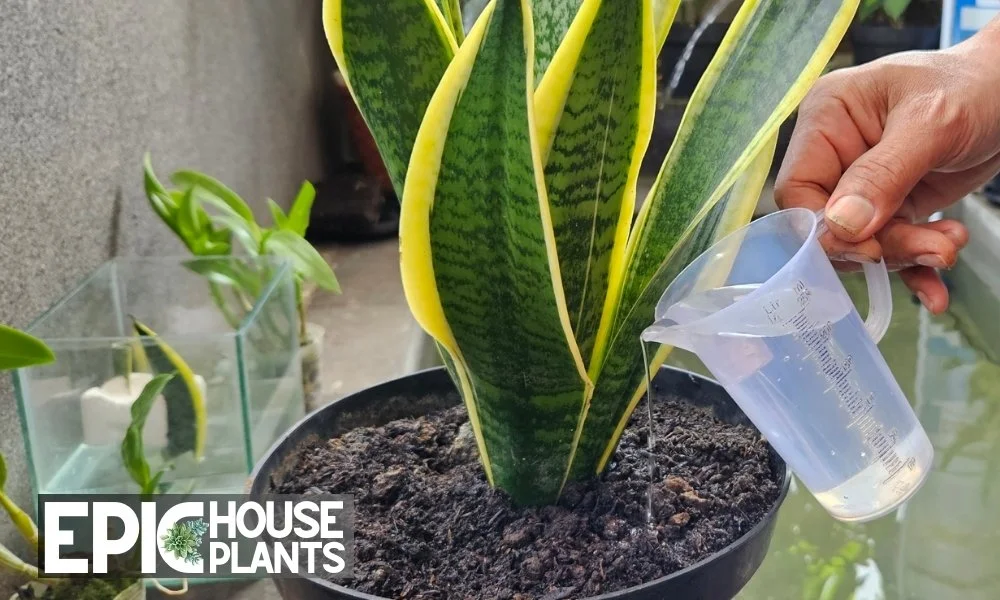Got a snake plant (also known as mother-in-law’s tongue or Sansevieria) that’s not quite thriving? Does its soil seem too dense and soggy? Sounds like it’s time for a pot switch!
Repotting is a game-changer for your leafy friend’s health and growth.
But, how to go about it? Fear not! This easy-to-follow guide is here to help you become a repotting wizard. We’ll walk you through everything – from picking the perfect soil to settling your plant in its new home.
So, let’s roll up our sleeves and treat your snake plant to some well-deserved pampering!
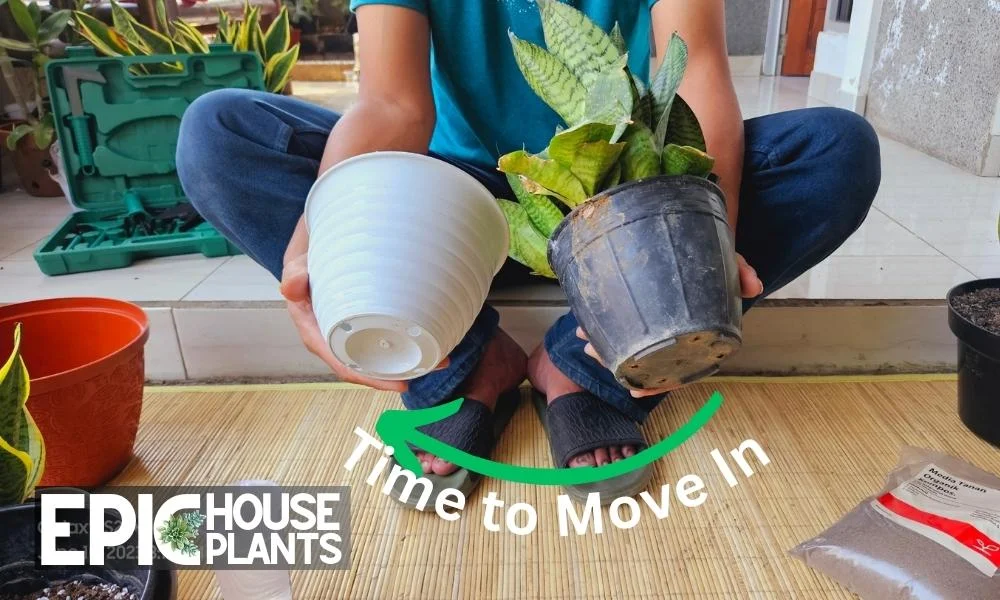
Is Your Snake Plant Ready for a New Home? Spot These 8 Clues
Snake plants are awesome, right? But did you know they sometimes outgrow their pots and need a fresh new home?
This means moving them to a bigger pot with some fresh soil. Here’s how to spot when your snake plant is saying, “Hey, I need more room!”
| Clue | Description |
|---|---|
| Roots Playing Peekaboo | If you notice roots sneaking out from the drainage holes at the bottom of the pot, it means your snake plant needs more space. |
| Thirsty Soil | Soil that dries out super-fast after watering is a hint that your plant needs repotting. Fresh soil in a new pot will help keep the plant hydrated. |
| Bulging or Cracked Pot | A bulging or cracked pot is a signal that your plant’s roots are too big for their home. Repotting into a roomier pot is necessary. |
| Leaning Tower of Plant | If your snake plant is leaning or seems too heavy at the top, it’s a sign that a new, larger pot is needed for stability. |
| Cramped Quarters | If your snake plant is squeezed in with barely any room to grow, repotting it can prevent overcrowding and associated diseases. |
| Slowpoke Growth | Slow or stunted growth in your snake plant is an indication that it needs more room. A larger pot will provide space for the roots to spread. |
| Unhappy Leaves | Wilting, yellow, or brown leaves could be due to the plant outgrowing its pot, or the soil being too packed. A larger pot with fresh soil can help. |
| Party of Pups | If your snake plant is hosting many “pups” (small plants growing next to the main one), a larger pot is needed. This gives both the mother plant and the pups space to thrive. |
So keep an eye on your snake plant and make sure it’s always in a pot that feels like home!
Also Read: The Ultimate Guide to Propagating Snake Plant in Soil
Best Season to Repot a Snake Plant
If you’re wondering about the perfect time to repot your snake plant, you should aim for the tail end of winter or the beginning of spring.
But why? Well, it’s because this is when the plant is getting ready to grow after resting during the colder months. Repotting at this time gives the plant a fresh start with new soil just as it’s gearing up to grow. It’s like giving it a springtime energy boost!
Author Note:
The snake plant is a hardy fellow and can be repotted in other seasons as well. This plant is tough and can handle a lot.
So, if you can’t repot it in late winter or early spring, don’t worry! Just make sure to give it a bit of extra care if you’re repotting in the hot summer or the chilly winter.
Additionally, last winter and early spring aren’t just the best times for repotting, but for pruning as well. Pruning means cutting back the plant a bit.
This helps the plant concentrate its energy on growing new, healthy parts. It’s like when you get a haircut to get rid of split ends, it makes your hair healthier.
So remember, late winter and early spring are like a spa time for your snake plant – perfect for repotting and pruning!
If you’re interested in learning more about how Snake Plants interact with their environment, our blog post on whether Snake Plants Can Live Outside is a must-read.
Getting Equipped: Your Snake Plant Repotting Toolkit
Ready to give your snake plant a brand-new home? You’ll need the right tools and materials to get the job done.
Here’s your beginner-friendly shopping list:
The Right Pot
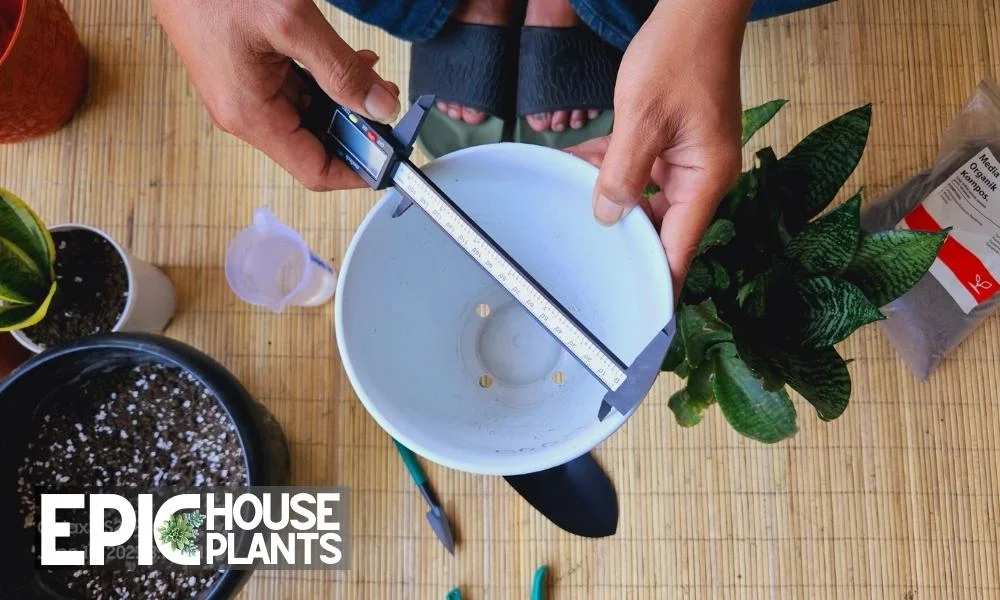
Choose a pot that’s just a couple of inches larger than the current one, with good drainage, and made from a material that suits your needs.
When it comes to pot size, bigger isn’t always better. A pot that’s too large can lead to overwatering since the soil will take longer to dry out. Aim for a pot that’s about 1-2 inches larger in diameter than the current one.
This gives your plant room to grow without drowning it in too much soil.
Fresh Potting Soil
Snake plants love well-draining soil. Look for a potting mix specifically designed for succulents or cacti. If you can’t find one, make your own by mixing regular potting soil with some perlite or sand for better drainage.
Author Note:
When repotting a snake plant, choosing the right soil is crucial. Check out the Best Soil for Snake Plant to discover the perfect soil options and learn how to create a custom potting mix. Your snake plant will thrive!
Gloves
Snake plants aren’t prickly, but it’s still a good idea to protect your hands when handling soil and roots. Plus, who wants dirt under their nails?
Trowel
This is like a mini shovel that helps you scoop soil in and out of the pot. If you don’t have one, don’t worry. A large spoon can also do the trick!
Watering Can
You’ll need this to give your plant a nice drink of water a week or so after repotting. Make sure it has a long spout for easy watering.
Newspaper or Drop Cloth
Repotting can get a little messy. Spread some newspaper or a drop cloth on your working surface to make the cleanup easier.
💡Make sure all your materials are clean and dry before you start repotting. It’s also a good idea to work in a clean and well-lit area, and to protect any surfaces that may get dirty during the process.
How to Repot a Snake Plant (6 Steps)
Are you ready to give your snake plant a bigger, better home?
Great! Here’s a simple step-by-step guide to repotting your plant. Whether you’re a beginner or a seasoned plant lover, you’ll find these tips super helpful. Let’s dig in!
Step 1: Prep Your Workspace
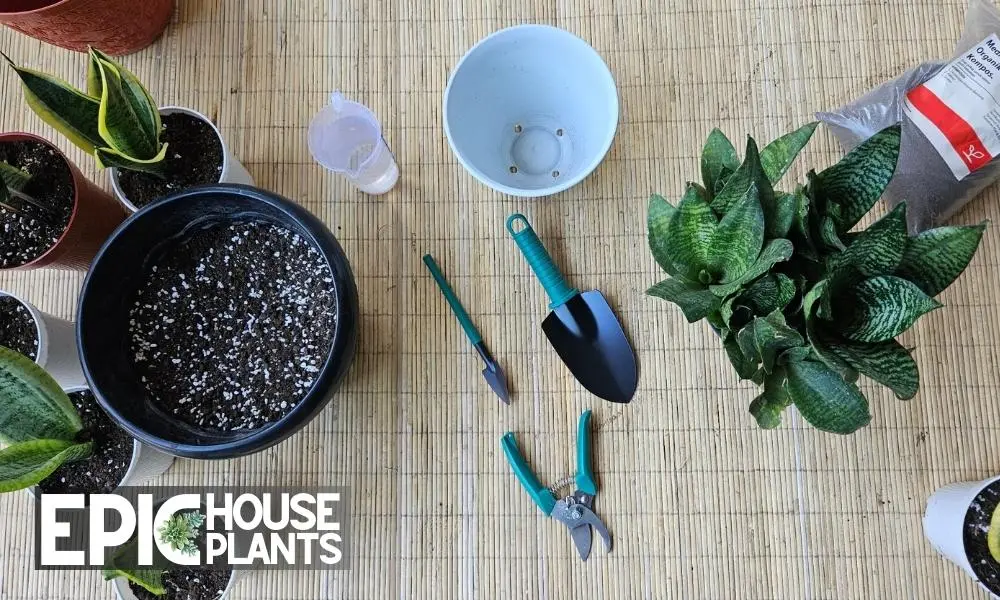
Start by laying down some newspaper or a drop cloth. Trust me, things can get a bit messy! Next, grab your new pot, fresh potting soil, trowel, gloves, and your snake plant. Make sure your new pot has been cleaned well to prevent any disease or pests.
Step 2: Set the Stage
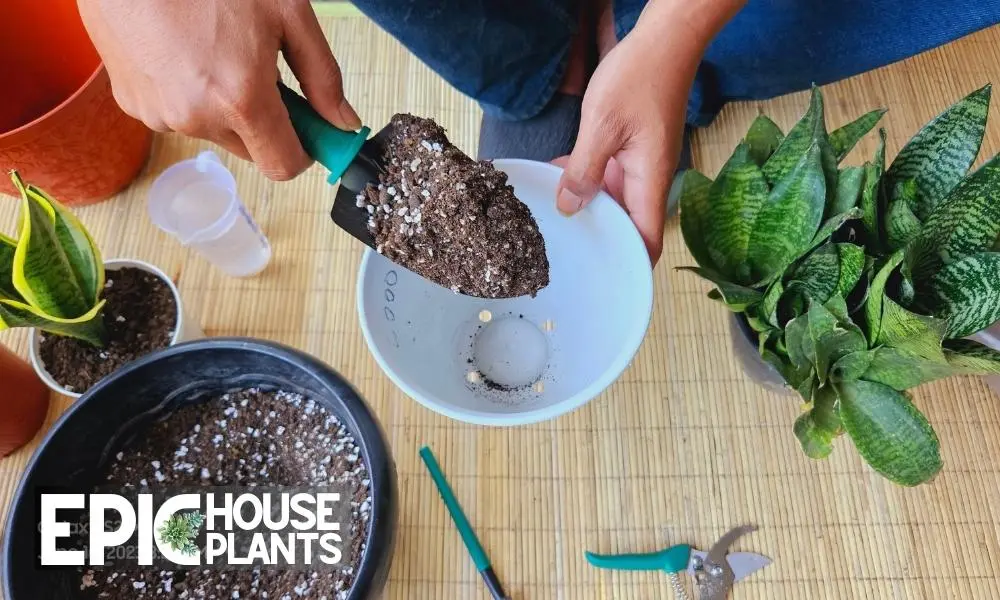
When repotting a snake plant, it’s important to get the new pot ready beforehand. This will make the potting process easier when it’s time to transplant the snake plant.
Place a little bit of your fresh potting soil at the bottom of the new pot. This creates a nice base for your plant to sit on.
Step 3: Free the Plant
Free the Plant Put on your gloves, and gently slide your snake plant out of its old pot.
A little tip: if it’s stuck, try squeezing the sides of the pot or tapping the bottom to loosen it up. Be gentle, though. You don’t want to damage those precious roots!
Step 4: Check the Roots

Check the Roots Now’s the time to give the roots a quick health check. Look for any signs of rot or damage. If you find any, just snip them off with clean scissors. If the roots are tightly wound in a circle (we call this ‘root-bound’), gently tease them apart with your fingers.
Step 5: Time to Move In
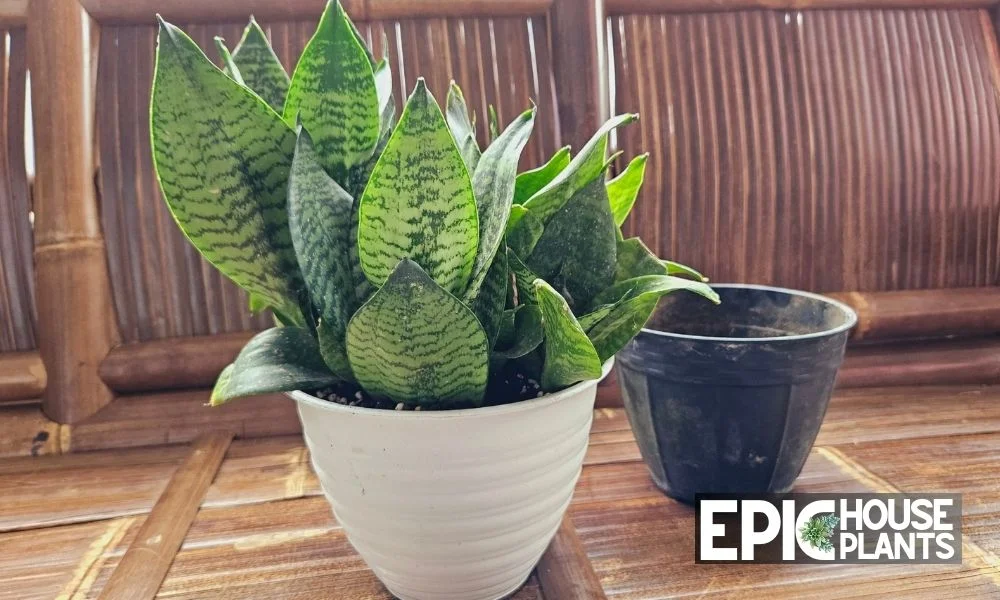
Place your plant into the center of the pot. You want the top of the root ball to sit about an inch below the rim of the pot. This leaves enough room for watering without overflow.
Once it’s in, start filling in the sides with more potting soil. Use your fingers or a trowel to gently press the soil down.
Step 6: Final Touches
Final Touches Once your plant is securely in its new home, give the soil a final firming by gently pressing down with your hands. Leave about an inch of space from the soil surface to the top of the pot. This prevents water from spilling over when you water your plant.
And that’s it! You’ve successfully repotted your snake plant. Remember, plants are living beings, and they need time to adjust to new surroundings.
So if your snake plant seems a little upset after the move, give it some time. With your love and care, it will soon start to thrive in its new home. Happy repotting!”
Also Read:
Discover the secret to multiplying your Sansevieria collection with our easy guide on propagating snake plant in water – it’s simpler than you think!
Post Repotting Snake Plant Care
Congrats! Your snake plant has a new, roomier pot. But the job’s not over yet. It’s now time to help your plant settle into its new home.
Here are some easy-peasy tips to take care of your snake plant post-repotting:
Water Wise
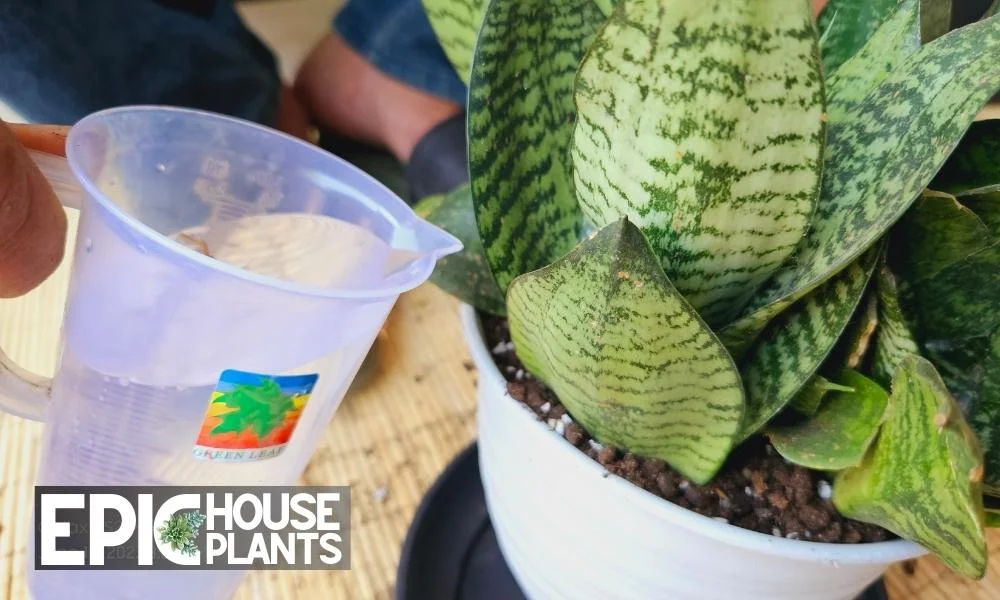
While it’s generally recommended to wait for a week before watering a repotted plant, if you wish to water immediately after repotting, make sure to do so lightly.
Be cautious not to overwater as this can lead to root rot, a common issue with snake plants. Afterwards, allow the soil to nearly dry out between waterings, as snake plants are succulents and too much water can cause their roots to rot.
Light it Right
Your snake plant loves light, but not too much of it. Keep it in a spot with indirect sunlight. A place near a north-facing window would be ideal.
Baby Steps with Fertilizer
Wait a bit before feeding your snake plant with fertilizer. Start with a mild, diluted fertilizer about a month after repotting. Remember, less is more when it comes to feeding your snake plant.
Room Temperature
Snake plants enjoy the same temperatures we do. So, keep your plant in a room where the temperature is between 70 and 90 degrees Fahrenheit (21-32°C).
Watch for Warning Signs
Keep an eye on your plant after the move. If you see any wilting or yellowing leaves, it may be a sign your plant is stressed.
But don’t panic! This can be normal after repotting. Just give it some time to adjust. If the signs persist, consider seeking advice from a plant expert.
Patience, Patience, Patience
Plants, like people, need time to adjust to new surroundings. So don’t worry if your snake plant seems a bit slow to grow initially. It’s just getting used to its new digs.
Remember, moving is tough, even for a plant. But with a little care and a lot of love, your snake plant will soon feel at home in its new pot. Happy Plant Parenting!
FAQs
Q: How often should I repot my snake plant?
A: Snake plants are slow growers, so they usually only need repotting every 2-3 years. But keep an eye on the clues your plant gives you. If it seems to be outgrowing its pot or showing signs of distress, it may be time for a new home.
Final Words
In conclusion, repotting your snake plant is a simple yet crucial step to keep your houseplant thriving. By choosing the right soil, pot, and following the proper techniques, you can ensure your plant’s roots remain healthy and provide the best environment for growth.
With this comprehensive guide, you can confidently repot your snake plant like a pro, giving it the care it deserves and enjoying a healthier, happier plant in return.
Author

Pudji Haryanto
Pudji Haryanto is a writer and urban farmer with a passion for cultivating plants. He has over 15 years of experience in agriculture and currently manages a 65,000 square foot rice-field and yard filled with various plants, including vegetables, spices, flowers, and garden plants.

